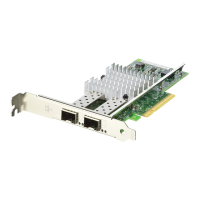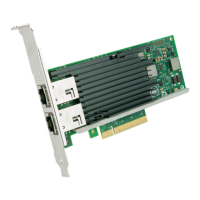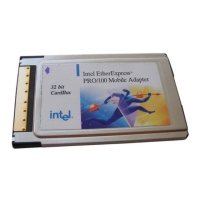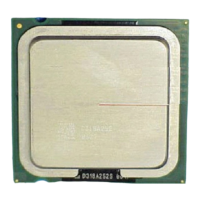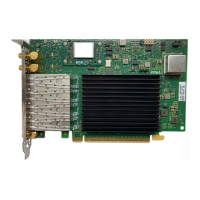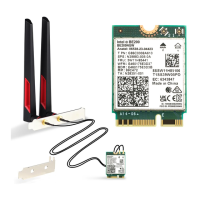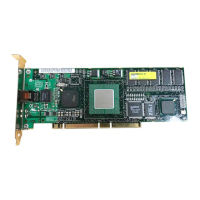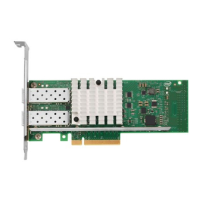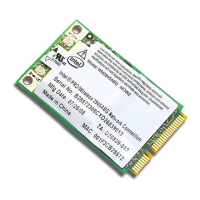I/O Virtualization Features
Features Benefits
Eight transmit (Tx) and receive (Rx) queue pairs per port • Supports VMware* NetQueue and Microsoft* VMQ
Flexible Port Partitioning:
32 Virtual Functions on Quad-port or 16 Virtual Functions on
Dual-port
• Virtual Functions (VFs) appear as Ethernet Controllers in Linux OSes that can be assigned to VMs, Kernel processes or
teamed using the Linux* Bonding Drivers
Support for PCI-SIG SR-IOV specication • Up to 8 Virtual Functions per Port
Rx/Tx Round-Robin Scheduling • Assigns time slices in equal portions in circular order for Rx/Tx for balanced bandwidth allocation
Trafc Isolation • Processes or VMs can be assigned a dedicated VF with VLAN support
Trafc Steering • Ofoads sorting and classifying trafc in to VF or queues
VM to VM Packet forwarding (Packet Loopback) • On-chip VM-VM trafc enables PCIe* speed switching between VM
MAC and VLAN anti-spoong • Enables anti spoong lter on MAC addresses and VLAN for VFs.
Malicious driver detection • Monitors queues and VFs for malformed descriptors that might indicate a malicious or buggy driver.
Storm control • Limits to the broadcast or multicast trafc it can receive
Per-pool statistics, ofoads, and jumbo frames support • Each Queue Pair or Pool has its own statistics, off-loads and Jumbo support options
Independent Function Level Reset (FLR) for Physical and Virtual
Functions
• VF resets only the part of the logic dedicated to specic VF and does not inuence the shared port
IEEE 802.1q Virtual Local Area Network (VLAN) support with VLAN
tag insertion, stripping and packet ltering for up to 4096 VLAN
tags
• Adding (for transmits) and removing (for receives) of VLAN tags with no VM involvement
• Filtering packets belonging to certain VLANs
IEEE 802.1q advanced packet ltering • Lower processor utilization
Mirroring rules • Ability to reect network trafc to a given VM or VLAN based on up to four rules
Support for Simple VEPA • Support for external VM switching
VF Promiscuous modes • VLAN, unicast, multicast
Stateless Ofoads/Performance Features
Features Benefits
TCP/UDP, IPv4 checksum ofoads (Rx/ Tx/Large-send); Extended
Tx descriptors for more ofoad capabilities
• Improved CPU usage
• Checksum and segmentation capability extended to new standard packet type
IPv6 support for IP/TCP and IP/UDP receive checksum ofoad • Improved CPU usage
Tx TCP segmentation ofoad (IPv4, IPv6) • Increased throughput and lower processor usage
• Compatible with large-send ofoad
Transmit Segmentation Ofoading (TSO) • Large TCP/UDP I/O is segmented by to the device it to L2 packets according to the requested MSS
Interrupt throttling control • Limits maximum interrupt rate and improves CPU utilization
Legacy and Message Signal Interrupt (MSI) Modes • Interrupt mapping
Message Signal Interrupt Extension (MSI-X) • Dynamic allocation of up to 25 vectors per port
Intelligent interrupt generation • Enhanced software device driver performance
Receive Side Scaling (RSS) for Windows environment
Scalable I/O for Linux environments (IPv4, IPv6, TCP/UDP
• Up to eight queues per port
Support for packets up to 9.5K Bytes (Jumbo Frames) • Improves the system performance related to handling of network data on multiprocessor systems
• Enables higher and better throughput of data
Low Latency Interrupts • Based on the sensitivity of the incoming data, the controller can bypass the automatic moderation of time intervals between
the interrupts
Header/packet data split in receive • Helps the driver to focus on the relevant part of the packet without the need to parse it
PCIe v2.1 TLP Processing Hint Requester • Provides hints on a per transaction basis
Descriptor ring management hardware for Transmit and Receive • Optimized descriptor fetch and write-back for efcient system memory and PCIe bandwidth usage
Remote Boot Options
Features Benefits
Preboot eXecution Environment (PXE) ash interface support • Enables system boot up via the EFI (32 bit and 64 bit)
• Flash interface for PXE 2.1 option ROM
Intel® Ethernet iSCSI Remote Boot for Windows, Linux, and VMware • Enables system boot up via iSCSI
• Provides additional network management capability
Intel Boot Agent software:
Linux boot via PXE or BOOTP, Windows* Deployment Services, or
UEFI
• Enables networked computer to boot using a program code image supplied by a remote server
• Complies with the Pre-boot eXecution Environment (PXE) Version 2.1 Specication
4

